
Catalog excerpts

Creating a healthier and safer environment
Open the catalog to page 1
Technical Guidance Manual Winding Gear Control Systems
Open the catalog to page 2
Who we are & what we offer SE Controls are a specialist contractor providing a complete solution for both smoke ventilation and adaptive natural ventilation solutions, via façade and building envelope automation in several continents. With over 30 years experience within the façade automation industry, SE Controls offer complete turnkey solutions from design and manufacture to installation, commissioning and on-going maintenance, throughout the life time of the building. Uniquely, SE Controls are members of both FETA (The Smoke Control Association) and the CIBSE Natural Ventilation...
Open the catalog to page 3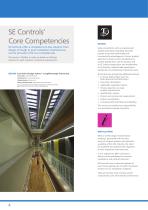
SE Controls’ Core Competencies SE Controls offer a complete turn-key solution from design, through to post installation maintenance, via the provision of 8 core competencies. The service is flexible, in order to deliver an efficient solution for each customer’s individual requirements. BELOW East Park Design School - Loughborough University LOCATION: LOUGHBOROUGH ARCHITECTS: NICHOLAS BURWELL CONSULTANTS: HOARE LEA MAIN CONTRACTORS: SHEPHERD CONSTRUCTION TGLA 24 65 LINEAR ACTUATORS INSTALLED TO ATRIUM VENTS, BMS INTERFACE VIA OS2 TYPE 24 CONTROLLER Design Early consultation with an...
Open the catalog to page 4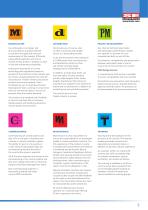
Project management Our philosophy is to design, test and manufacture products tailored to suit both the legal and technical requirements of the industry. Efficiently sustainability aesthetics and cost to market are key drivers in addition to ease of use and maintenance thereafter. Stock levels are, of course, vital to offer a proactive and reliable service to a demanding market. Our internal Technical Sales Teams and nationally located Project Leaders are “geared” to provide our core competencies both on and off site. Pushing the boundaries of current technology and regulations keeps our...
Open the catalog to page 5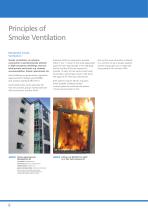
Principles of Smoke Ventilation Residential Smoke Ventilation. Smoke ventilation via window automation is predominantly utilised in high occupancy dwellings, that are both private and social, e.g. student accommodation, hotels, apartments etc. Such buildings are governed by regulation Approved Doc B design guide BS9991 and product standard EN12101-2. Automated smoke vents generally fall into two product groups namely staircase AOVs and end of corridor AOVs. Staircase AOVs are required to provide either 1.0 or 1.5 sq/m of free area dependant upon the stair type (escape or fire fighting). End...
Open the catalog to page 6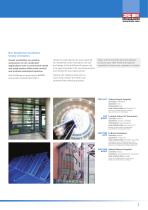
Non Residential Ventilation Smoke Ventilation. Smoke ventilation via window automation in non residential applications such as commercial health and retail sectors utilise both vertical and inclined automated solutions. Unlike the prescriptive free areas required for residential smoke ventilation, the size and design of the building will govern the vent type orientation free area requirements and method of area measurement. Such buildings are governed by BS9999 and product standard EN12101-2. Check with SE Controls Technical Advisors to ensure your offer meets the required regulations....
Open the catalog to page 7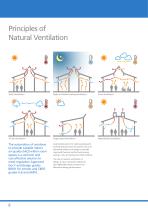
Principles of Natural Ventilation Stack Ventilation Night or Passive Cooling Ventilation Cross Ventilation Trickle Ventilation Single Sided Ventilation Mixed Mode Ventilation The automation of windows to provide suitable indoor air quality (IAQ) within room spaces is a common and cost effective solution to meet regulation Approved Doc F and design guides BB101 for schools and CIBSE guides A,B and AM10. Automating vents for night purging and cooling thermal mass has proven to be an extremely effective strategy to provide improved thermal comfort and energy saving in lieu of mechanical HVAC...
Open the catalog to page 8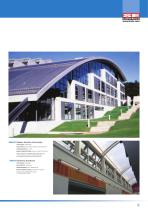
ABOVE Robert Gordon University LOCATION: ABERDEEN ARCHITECTS: BUILDING DESIGN PARTNERSHIP CONSULTANTS: KJ TAIT MAIN CONTRACTORS: MILLER CONSTRUCTION SECO 24 40 ACTUATORS INSTALLED TO TOP HUNG VERTICAL VENTS FOR AIR INTAKE & TO NORTH LIGHTS FOR AIR EXTRACT RIGHT Hackney Academy LOCATION: HACKNEY ARCHITECTS: STUDIO E CONSULTANTS: MAX FORDHAM MAIN CONTRACTORS: WILLMOTT DIXON CHAIN ACTUATORS INSTALLED TO TOP HUNG VENTS
Open the catalog to page 9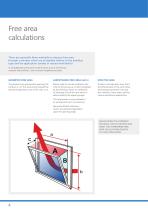
Free area calculations There are generally three methods to measure free area through a window which are all applied relative to the building type and the application (smoke or natural ventilation). In all applications be aware of obstructions such as framework, recesses, side walls etc., and of course neighbouring vents. Geometric Free Area Aerodynamic Free Area (AvCv) Effective Area The physical area produced by opening the window A + B. This area cannot exceed the maximum geometric area of the vent a x b. Mainly used for smoke ventilation the internal throat area a x b (Av) multiplied by...
Open the catalog to page 10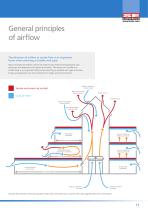
General principles of airflow The direction of airflow or smoke flow is an important factor when selecting a suitable vent type. Basic principles of airflow relative to external and internal temperatures and pressures will determine the optimum solution. The direction of airflow or smoke flow is an important factor when selecting a suitable vent type as certain hinge arrangements are more suited to air intake and smoke extract. Natural ventilation cold air intake Smoke and warm air extract Natural ventilation warm air outlet Smoke extract Cool air inlet Smoke extract Natural ventilation...
Open the catalog to page 11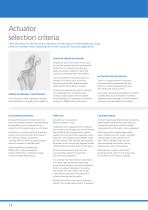
Actuator selection criteria The following 12 criteria are an indication of the types of information you may need to consider when choosing the correct actuator for your application. Chain or Linear Actuator? In general, chain drives tend to be used for vertical vents as they do not protrude within the room space, plus they can easily be powder coated to match the frames or concealed within the section. There are specific chain drives that are suitable for sloping vents which are very strong and have double strength chains (TGCO 24 50, 60 & 70 range) Actuator Size/Aesthetics There is a huge...
Open the catalog to page 12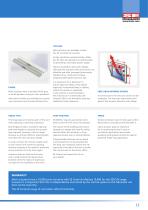
Voltage Most actuators are available in both 24v DC and 230v AC versions. Smoke ventilation predominantly utilises 24v DC that will operate via a battery back up providing a secondary power supply. Natural ventilation uses both voltages although 24v actuators tend to be more cost effective and offer increased functionality (tandem drive, multi point locking, programmable speed and force etc). Alternative finishes are available but usually cost a premium and increase delivery time. It is important for a fabricator to ensure electrical safety of the system especially if extended flexes or...
Open the catalog to page 13All SE Controls catalogs and technical brochures
-
NVLogiQ Brochure
8 Pages
-
Folding Arm Door Actuator
2 Pages
-
NVLogiQ Room Controller
2 Pages
-
Humidity Sensor
2 Pages
-
Stand Alone Rain Sensor
2 Pages
-
CO2 & Temperature Sensor
2 Pages
-
os2
2 Pages
-
6A 230V AC CONTROLLER
2 Pages
-
TGCO 24 20
2 Pages
-
TGCA 24 ED Locking Catch
2 Pages
-
SECO 20
2 Pages
-
SHEVTEC® Glazed Louvre AOV
1 Pages
-
SHEVTEC®
1 Pages
-
TGCO 24 30 ED
2 Pages
-
TGCO 24 30
2 Pages
-
TGCO 24 60
2 Pages






















